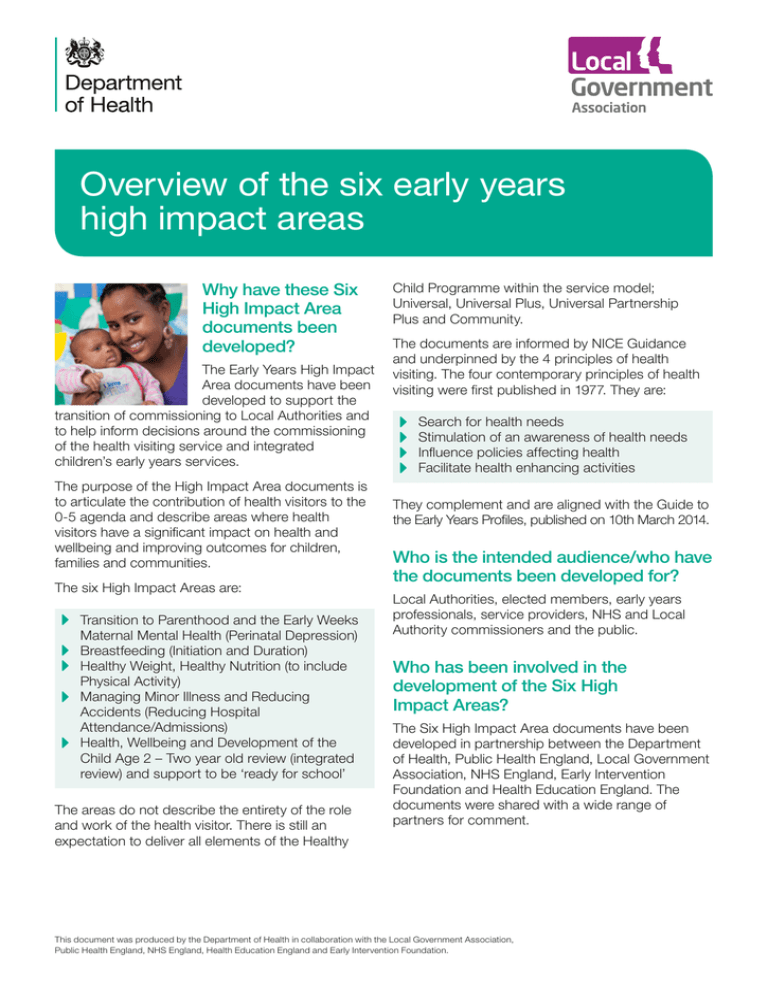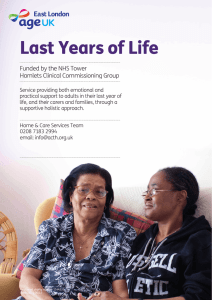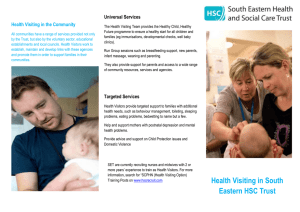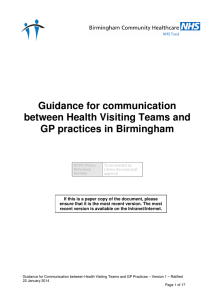Overview of the six early years high impact areas
advertisement

Overview of the six early years high impact areas Why have these Six High Impact Area documents been developed? The Early Years High Impact Area documents have been developed to support the transition of commissioning to Local Authorities and to help inform decisions around the commissioning of the health visiting service and integrated children’s early years services. The purpose of the High Impact Area documents is to articulate the contribution of health visitors to the 0-5 agenda and describe areas where health visitors have a significant impact on health and wellbeing and improving outcomes for children, families and communities. The six High Impact Areas are: nn Transition to Parenthood and the Early Weeks Maternal Mental Health (Perinatal Depression) nn Breastfeeding (Initiation and Duration) nn Healthy Weight, Healthy Nutrition (to include Physical Activity) nn Managing Minor Illness and Reducing Accidents (Reducing Hospital Attendance/Admissions) nn Health, Wellbeing and Development of the Child Age 2 – Two year old review (integrated review) and support to be ‘ready for school’ The areas do not describe the entirety of the role and work of the health visitor. There is still an expectation to deliver all elements of the Healthy Child Programme within the service model; Universal, Universal Plus, Universal Partnership Plus and Community. The documents are informed by NICE Guidance and underpinned by the 4 principles of health visiting. The four contemporary principles of health visiting were first published in 1977. They are: nn nn nn nn Search for health needs Stimulation of an awareness of health needs Influence policies affecting health Facilitate health enhancing activities They complement and are aligned with the Guide to the Early Years Profiles, published on 10th March 2014. Who is the intended audience/who have the documents been developed for? Local Authorities, elected members, early years professionals, service providers, NHS and Local Authority commissioners and the public. Who has been involved in the development of the Six High Impact Areas? The Six High Impact Area documents have been developed in partnership between the Department of Health, Public Health England, Local Government Association, NHS England, Early Intervention Foundation and Health Education England. The documents were shared with a wide range of partners for comment. This document was produced by the Department of Health in collaboration with the Local Government Association, Public Health England, NHS England, Health Education England and Early Intervention Foundation. Many of comments received have been addressed in final versions of the documents, however a number of comments were deemed to be outside of the scope of the six areas, these include: Future commissioning decisions Caseload numbers/workforce profile and grade Decisions on inclusion of additional reviews Child Health Systems and technicalities of how information is collected and reported nn Children with complex health needs and looked after children nn Performance management nn Supervision nn nn nn nn Key policy drivers nn The Health Visiting Programme - A Call to Action. Department of Health, 2011 nn Marmot M. Fair society, healthy lives: Strategic Review of health Inequalities in England post 2010. London: Marmot Review, 2010 nn Annual Report of the Chief Medical Officer 2012. Our Children Deserve Better: Prevention Pays. Department of Health, 2013 nn Healthy lives, healthy people: our strategy for public health in England. Department of Health, 2010 nn Healthy lives, healthy people: update and way forward. Department of Health, 2011 nn Healthy, lives healthy people: Improving outcomes and supporting transparency. Department of Health, 2013 nn Early Intervention: The Next Steps. An Independent Report to Her Majesty’s Government Graham Allen MP 2011 Core principles There are a number of principles that are common and assumed in each of the High Impact Area documents: nn Universal services are essential for primary prevention, early identification of need and early intervention. Universal services lead to early support and harm reduction nn Early intervention evidence-based programmes should be used to meet the needs and to ensure that needs are identified in a timely way nn All areas focus on improving health outcomes and reducing inequalities at individual, family and community level nn Outcome measures align between health and education/other early years providers and there should be shared outcomes across the system nn Safeguarding is a thread throughout all of the six areas ranging from identification of risk and need, to early help and targeted work, through to child protection and formal safeguarding nn Clinical judgement will be used alongside formal screening and assessment tools nn Health visitors have an important role as leaders of the Healthy Child Programme which should form part of multi-professional care pathways and integration of services for children 0-5 nn Public health, health promotion, prevention and safety is covered during every contact nn It is recognised that early years practitioners, voluntary organisations, peer supporters, Family Nurse Partnerships, GPs and primary and secondary care providers all have an important contribution to make toward delivery of child health outcomes nn Partnership, integration, communication and multi-agency working are key to improving outcomes nn Outcomes are measured in line with national outcome frameworks and commissioning reporting requirements; however other reporting requirements and measures are for local determination nn Additional outcome measures should not add burden to data collection, be collected within current systems and align to national reporting requirements nn Engagement with fathers and the family is an important component of the Healthy Child Programme Pauline Watts Nursing Professional Officer/Clinical Advisor Public Health Nursing & National Health Visitor Programme Department of Health Email: Pauline.Watts@dh.gsi.gov.uk 1 July 2014






